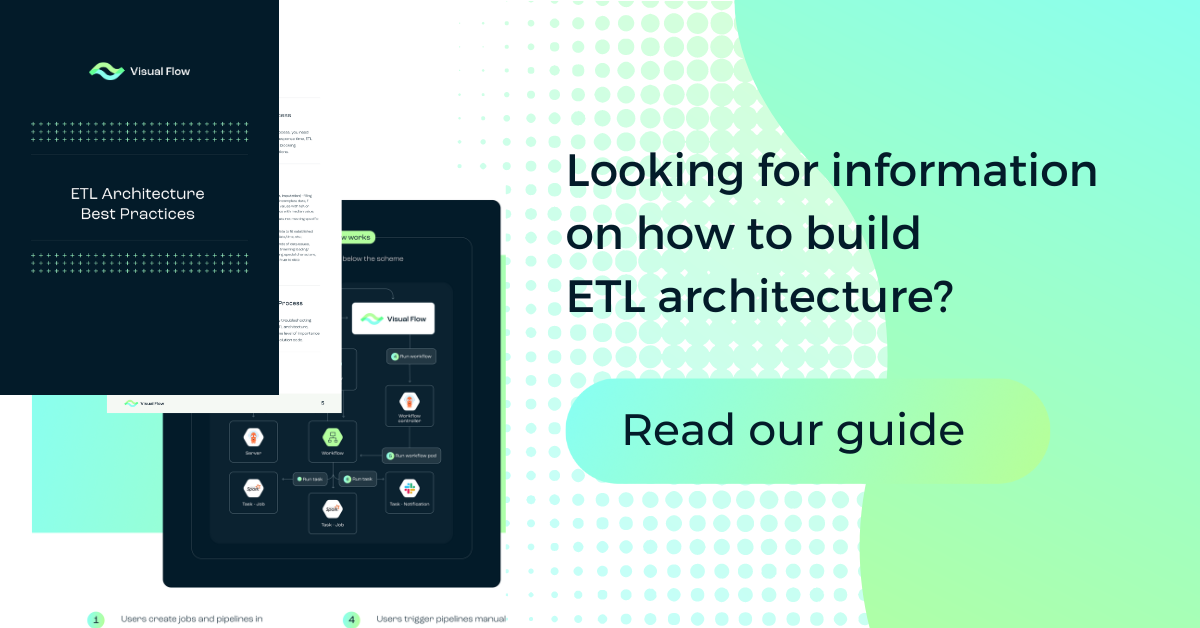
Table of Content:
Table of Content:


Nowadays, ETL design patterns are fundamental. Because they handle data extraction, conversion, and loading cleanly — guaranteeing efficiency and consistency across systems — it is vital to know them well to build reliable and scalable data operations.
Introduction to ETL Design Patterns
The ETL (extract, transform, load) design pattern is widely used in data engineering. It involves obtaining raw data from many sources, cleaning it up to fit a certain model or format, and loading it into a target system, such as a database or data warehouse.
What Is an ETL Design Pattern?
The ETL (extract-transform-load) design pattern has dominated data pipeline techniques for a considerable period. Since the ’90s, it has set the standard for data warehousing and continues to do so in modern digital environments like data lakes, operational data stores, and master data hubs. Imagine a process that extracts data from operational databases, transforms, cleanses, and integrates it, and then gracefully inserts it into a destination database.
The ETL design pattern typically operates on a schedule, processing data in batches, and yes, this does mean some lag time. Although micro- and mini-batch techniques may reduce waiting time, achieving 0% delay is an unrealistic expectation. However, the ETL pattern is your greatest friend when dealing with complicated data transformations, particularly when data arrives at various times from diverse sources. As each data source is ready, it’s meticulously extracted solo. After everything is ready to go, the last step is to load the full data set into its new home after a transformation. This pattern is especially helpful for use cases involving machine learning, which often concentrate on a small number of fields within much larger data sets.
Understanding Key ETL Components
Gathering data from many sources — including databases, spreadsheets, or applications — opens the ETL process’s extraction phase. It consists of determining the pertinent data, grasping its structure, and creating secure access and retrieval strategies.
Data collection marks the start of the transformation process. Cleaning, standardizing, and improving the data help to prepare it for the target system. Converting data formats, implementing business rules, and standardizing values are common activities here. The goal is to ensure that every system keeps constant and correct data.
During the transformation phase, any errors, discrepancies, or duplicates that could have entered the data during extraction are removed. Standardization ensures that data follows certain formats and norms, therefore facilitating flawless integration. Additionally, this step offers the chance for data enrichment, incorporating valuable context or metadata to improve analysis and decision-making.
Loading the changed data into a destination system — usually a data warehouse or database — is the final phase of the ETL process. This is an important step since it affects how readily and successfully the data can be utilized for reporting and analysis.
Types of ETL Design Patterns
The most popular types of ETL design patterns include:
- Incremental loading. Incremental loading is a clever design strategy that focuses on getting just the new or updated data from the source rather than loading the complete dataset each time. It cuts down on data transmission, conserves network capacity, and slashes processing time. To identify changes in the source data, incremental loading leverages timestamps, version numbers, flags, and change data capture (CDC) techniques. Popular ETL frameworks that accept incremental loading include Apache Airflow, Apache NiFi, and Talend.
- Parallel processing. This approach divides massive data sets into smaller, doable chunks handled concurrently over many threads, cores, or nodes. It transforms ETL processes’ scalability and performance, therefore acting as a powerhouse for managing enormous amounts of data. Strategies such as batching, partitioning, or streaming effectively divide and conquer data. Parallel processing is supported by frameworks such as Apache Spark, Apache Flink, and AWS Glue.
- Staging area. Acting as a smart middleman, a staging area stores extracted data in locations like a temporary table or file system until it changes and loads into its ultimate location. Many benefits come from this strategic arrangement: it separates source and target systems, permits complete data purification and validation, and streamlines data reconciliation and auditing. It also allows for parallel computing and gradual loading. Staging areas are highly used in ETL systems, such as SSIS, Pentaho, and Informatica.
- Batch processing. In ETL systems, batch processing groups or batches of data are under predetermined intervals. This approach is very effective for managing big data quantities without real-time processing required. Data in pieces helps batch processing maximize resource use and improve speed. ETL frameworks like Apache Hadoop, Talend, and Informatica are well-suited for this approach.
The kind of your data and the demands of your system will determine the correct pattern for you.
Step-by-Step Guide to Building an ETL Design Pattern
This guide will show you how to create a successful ETL design pattern:
- Find out where your data originates from: APIs, spreadsheets, or databases. Take your time learning the ins and outs of the data format.
- Now is the time to figure out how to get data from your sources in a way that won’t interrupt anything. Think about how often you should extract data; do you need updates in real time, or would a batch or incremental method be better? Make sure data is flowing consistently by using tools that are tailor-made for this procedure.
- Data standardization, enrichment, and cleansing are the next steps. Create transformation rules that apply business logic without compromising data integrity.
- Once the transformation is complete, the data is sent to a data warehouse or another suitable location. Think ahead about how you’ll arrange the data so that it’s simple to find and evaluate. In this case, techniques like indexing and partitioning are invaluable.
- If you have solid error handling and tracking in place, you can turn mistakes into chances to learn. Set up systems to record exceptions and problems, and make sure you get notifications when anything major goes wrong.
- Make sure your ETL process is fully tested and validated before releasing it to the public. Verify the correctness of data extraction, transformation, and loading by running test cases.
A major component of maintaining an effective ETL pattern is doing frequent checks. Monitor the logs and performance metrics for any signs of trouble, and always be one step ahead of data growth by keeping the system up to date.
Best Practices for ETL Design
Before you begin handling data, familiarize yourself with the data types, formats, and volumes involved to guarantee consistency in your company processes. Data sources often come from databases or software-as-a-service apps (SaaS), such as HubSpot and Salesforce.
Eliminate data problems during a single ETL cycle to prevent reaccurance. To do this, you may use tools like autocorrect tasks to fix common mistakes and enforce data validation rules. If problems still arise, you can consult with your source partners to fix them and guarantee accurate results.
You must keep meticulous records of all events that occur before, during, and after an ETL design process if you want to be able to tweak and enhance your ETL tactics as needed. Also, be sure to put up checkpoints so you can monitor your progress and gracefully deal with problems. In the case of a failure, this procedure keeps data processing continuous and efficient by avoiding the need to start the whole process from the beginning. Even when there are no obvious mistakes, conducting regular audits will help you make sure the process is running well.
To make ETL procedures more manageable and reusable, break them down into smaller pieces. Modularity creates a consistent structure for processes, simplifies unit testing, and decreases code duplication.
Make sure your data preparation space is safe by limiting who may access it and giving permissions carefully. It safeguards information from prying eyes and keeps records accurate. When it comes to illegal access or security breaches in particular, you may set up alerts to help you discover mistakes quickly and fix them.
For additional information, read our blog about best practices for ETL data modeling, and don’t hesitate to contact Visual Flow if you need professional advice.
Challenges and Solutions in ETL Design Patterns
A major challenge with ETL patterns is making sure data stays intact. The reliability and correctness of your analysis might be called into question if the data you used is inconsistent or otherwise incorrect. The ETL procedure relies on data that is compatible and consistent across several sources to provide a smooth integration. However, the process may be delayed or even halted due to discrepancies in format, structure, and value across different sources. There is usually a need to put a lot of effort and money into cleaning and standardizing data since it is full of mistakes, duplication, or contradictory information.
Processing bottlenecks are another common problem with ETL. Systems could have trouble effectively processing data if its volume keeps growing. This causes data updates to be slow, which means that information becomes old before it can be used efficiently.
Additionally, upgrades and maintenance are made more difficult since ETL scripts sometimes depend on manually developed code. If the source or destination data structures undergo even small changes, it may be necessary to rebuild these scripts from the ground up.
Security is also a major issue. There are several potential entry points for hackers when data travels across different systems. Data management and compliance are severely constrained by strong privacy standards like GDPR and HIPAA, which makes the problem worse. Nonetheless, ETL is still vital to many corporate operations, even with these obstacles.
Conclusion: Why Solid ETL Design Patterns Matter
Effective data management depends on ETL patterns. Crucially for preserving consistency and accuracy, these patterns provide a methodical strategy to convert data. Companies may create a strong data infrastructure that helps improve decision-making and insights and adapt to changing corporate needs.
However, remember that no-code and low-code platforms streamline ETL with pre-built connections, easy-to-use data mapping interfaces, and data purification tools — all without requiring tedious coding duties. In addition, they make it simple to integrate with data warehouses, which helps organizations handle data effectively even without highly skilled staff.








Contact us






















































